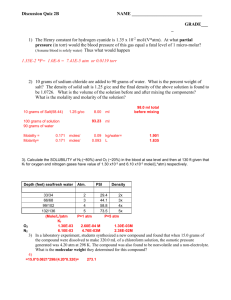
That is exactly what it says it is - the fraction of the total number of moles present which is A or B. X A and x B are the mole fractions of A and B. The P o values are the vapour pressures of A and B if they were on their own as pure liquids. The total vapour pressure of the mixture is equal to the sum of the individual partial pressures. Even if you took all the other gases away, the remaining gas would still be exerting its own partial pressure. This is called its partial pressure and is independent of the other gases present. In any mixture of gases, each gas exerts its own pressure. In this equation, P A and P B are the partial vapour pressures of the components A and B.

In equation form, for a mixture of liquids A and B, this reads: Raoult's Law only works for ideal mixtures. The partial vapour pressure of a component in a mixture is equal to the vapour pressure of the pure component at that temperature multiplied by its mole fraction in the mixture. The definition below is the one to use if you are talking about mixtures of two volatile liquids. You may have come cross a slightly simplified version of Raoult's Law if you have studied the effect of a non-volatile solute like salt on the vapour pressure of solvents like water. If the temperature rises or falls when you mix the two liquids, then the mixture isn't ideal. That means that an ideal mixture of two liquids will have zero enthalpy change of mixing. If all these attractions are the same, there won't be any heat either evolved or absorbed. When you make any mixture of liquids, you have to break the existing intermolecular attractions (which needs energy), and then remake new ones (which releases energy). Ideal mixtures and enthalpy change of mixing However, they obviously aren't identical - and so although they get close to being ideal, they aren't actually ideal.įor the purposes of this topic, getting close to ideal is good enough! They are similarly sized molecules and so have similarly sized van der Waals attractions between them. This is why mixtures like hexane and heptane get close to ideal behaviour. If you follow the logic of this through, the intermolecular attractions between two red molecules, two blue molecules or a red and a blue molecule must all be exactly the same if the mixture is to be ideal. They must also be the same otherwise the blue ones would have a different tendency to escape than before. If the forces were any different, the tendency to escape would change.Įxactly the same thing is true of the forces between two blue molecules and the forces between a blue and a red. If the red molecules still have the same tendency to escape as before, that must mean that the intermolecular forces between two red molecules must be exactly the same as the intermolecular forces between a red and a blue molecule. If the proportion of each escaping stays the same, obviously only half as many will escape in any given time. That means that there are only half as many of each sort of molecule on the surface as in the pure liquids. The diagram is for a 50/50 mixture of the two liquids. You might think that the diagram shows only half as many of each molecule escaping - but the proportion of each escaping is still the same. In an ideal mixture of these two liquids, the tendency of the two different sorts of molecules to escape is unchanged. At any particular temperature a certain proportion of the molecules will have enough energy to leave the surface. If you have a second liquid, the same thing is true. The smaller the intermolecular forces, the more molecules will be able to escape at any particular temperature. In a pure liquid, some of the more energetic molecules have enough energy to overcome the intermolecular attractions and escape from the surface to form a vapour. These are mixtures of two very closely similar substances.

There is actually no such thing as an ideal mixture! However, some liquid mixtures get fairly close to being ideal. The page will flow better if I do it this way around. Use the BACK button on your browser to return to this page when you are ready.Īn ideal mixture is one which obeys Raoult's Law, but I want to look at the characteristics of an ideal mixture before actually stating Raoult's Law. Important: If you haven't already read the page about saturated vapour pressure, you should follow this link before you go on. The page explains what is meant by an ideal mixture and looks at how the phase diagram for such a mixture is built up and used. It covers cases where the two liquids are entirely miscible in all proportions to give a single liquid - NOT those where one liquid floats on top of the other (immiscible liquids). This page deals with Raoult's Law and how it applies to mixtures of two volatile liquids. RAOULT'S LAW AND IDEAL MIXTURES OF LIQUIDS Raoult's Law and ideal mixtures of liquids


 0 kommentar(er)
0 kommentar(er)
